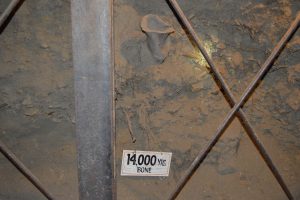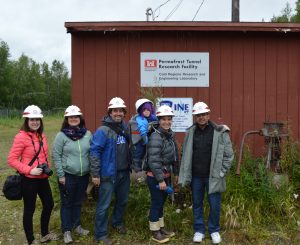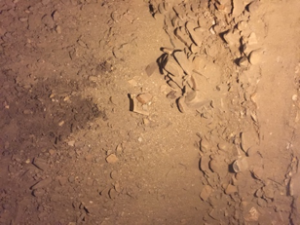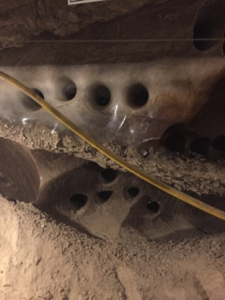20 July 2016 — Day 7 Excursions: Wickersham Dome Hike, Canoe Float on the Chena River, and Permafrost Tunnel Tour
Wickersham Dome Hike
Blog post by Stan Edwin, Alaskan Gwich’in, University of Alaska Fairbanks, USA
On Wednesday morning, ten of us, students and faculty of ICRPS, signed up for a hike through the wilds of Alaska. Since we are an international group, we are all endowed with certain forms of expectations, worries and desires of what to expect. Some wanted the majestic views of rolling hills of Boreal forests as seen in magazines and books, others a glimpse of the real Alaska, including wildlife.
Well Alaska does not disappoint, with the exception of animals. I constantly reminded them that there is certain wildlife they would not want to see; especially with our only defense our guide’s bear spray. It was low overcast with a hint of rain or drizzle in the air when we all boarded the UAF van. It was planned that we walk from the Dall road, the pipeline road, through a walking trail to the top of Wickersham dome, a good few miles out.
When we arrived at our trail head, we all prepared, it was a little cool but not wet nor windy, was low overcast and humidity high, slightly damp air, but not wet; the grass and leaves were wet from morning dew. As we started out, due to our altitude and the low overcast, we were literally in the cloud. As some raced on, the idea of a hike of some is more towards health and exercise than a walk in nature, a race.
As most of our cohort scurried off down the trail, I chose to bring up the rear since this is the land of my peoples, the Gwich’in, and the land of my birth. As a few of us stragglers straggled along, we started looking for different types of fauna and what berries we could find. The more exertion you did, the easier it was to sweat and chillier you got, mostly due to the humidity. Was a little too chilly in the clouds this morning for our state bird, the mosquitoes. Joke! Lucky for them, not the mosquitoes!!!
We’ve seen blueberries, low bush cranberries, salmon berries, later crow berries and black berries. When we caught up with the group, I asked what they saw on the trail, anything we could eat, only blue berries was the reply. This was a good time, walking slow and observing the abundance of the land, talking also and getting to know each other. We disclosed our lives, expectations and plans of where we are going and why we are here at ICRPS, personal information only close friends would be privy to. Laura and I walked together for a bit, each learning the culture and lives we have lead. Later Erika and I would do the same as well, but we will get to that.
The trail was nothing like the trails a person would find in the lower 48 parks, nice and built, nope, our trails were Alaskan trails. A foot path un-kept and wet with puddles and small flowing runoffs with the bushes being wet, and as such your trousers around your feet. We seen a number of different mushrooms, being it so damp, and while in the cloud no animals large or small, nor bugs or mosquitoes. I was constantly asked about the mushrooms, which could be eaten and which bad. Unfortunately that knowledge is gone, lost with our elders of time since past, I did not know these answers. Though some things are lost to time, new things are learned and fill the gap of knowledge lost.
As we approached the tree line, and the cloud being so low, our view was limited to around hundred feet. Disappointment for some whom were expecting to see the view of Alaska hills off into the distance, but reminding them that what they can see has its own value, differing foods of berries, and the lit-dee-musket tea, also known as Labrador Tea.
Told Laura that the sun would not dissipate the cloud, fog, but the wind may blow it away. As we came upon a small protrusion of rocks, the wind picked up and the chill of being damped and sweating started to set in as the cloud started to move. Everyone started to feel the chill of being damp, and our feet getting wet. The energy required for trekking about the Alaskan wilderness above the tree line in such weather, hunger and the weariness of being damp and slightly chilly from the wind started to settle in, the discomfort and slight disappointment of expectations. Even I the Alaskan started to feel the discomfort and weariness.
Upon the protrusion of rocks at our destinations end, we all ate our sack lunch as we hid from the wind behind rock outcroppings. Comradery and spirits were high among my new friends. I think the experience of seeing and experiencing the real Alaska they wished for started to take a bigger value over the expectation instill through magazines and pictures to entice tourists. These are smart and insightful people those that attend ICRPS; an international accumulation of good hearts, thoughtful, and insightful people. Couple people of the group, those from the chillier and higher altitude countries in Europe. They, a few displayed little to no effects by the wind and dampness, I think they are well adapted to the small discomfort.
On our return, retracing our walk out, the wind started to pick up; fortunately most of the trail we walked in was behind the hill out of the wind as we walked out. By the time we got to the tree line the cloud started to dissipate, and our view over the landscape grew in distance. Soon those that were expecting the majestic view of rolling hills of boreal forests got their wish. As it started clearing up and the land got drier, birds started coming out, and a few mosquitoes, only a few nothing like the bombardment we Alaskan’s know and expect to be true.
Erika and I took our time walking back, some of the group waited from time to time, but finally gave up on waiting and soon we lost the noise of them to distance. We took pictures of the rolling hills of Alaska’s White Mountains, and Erika has a couple look at me I’m in Alaska pictures. Fortunately the mosquitoes were but a few, or I would have had a mad woman on my hands if there were any more in numbers greater than one, even that one with it’s bzzzz constantly in here ear was more than enough.
As we walked, we exchanged and talked of who we are; our families and places we are from, things friends would know. In doing all this on our slow trek, we reexamined all the different berries and the land about. As we approached our starting point, the group was on a small hill waiting patiently. They had no expectation of being in a rush, for the view from that small hill of where we were and went unable to see before was now laid out before us. A picture moment of and for the group and individuals, we rested and sheared stories for a moment.
On our ride back, we stopped at the Hill Top gas station, eatery and had pie. The pie idea was suggested by our guide, Curtis. Our guides, even though he was raised in Anchorage and the young lady accompanying him as our secondary, though they started knowing everything, arrogance. They too started fitting in, and at the end they learned something new, not only of the woods but of the people accompanying them. In the end, I would safely say we all are now friends, and all have learned new things and have an experience of Alaska we not only wanted but needed.
River Float on the Chena River
Blog post by Nadinne Gonzalez Romero, Universidad Autónoma del Estado de México, México
The rest day was not exactly a break, five hours paddling on the Chena River is an experience I will never forget, while you let the river take up his cause in one hand the boreal forest in conjunction with the Chena River offer fresh air and beautiful landscapes through which you remember the spectacular nature, on the other hand, technology is present with military aircraft and helicopters flying over your head.
Teamwork in this activity was essential to direct the canoe well while facing many water currents. It was difficult, because sometimes our arms feel tired, but the opportunity to see a moose with her calf and an eagle flying over the area was worthwhile. How long we can continue to enjoy the services that nature provides us if we do not realize that all our activities impact the environment? It is a question that remains in the air and people should seriously answer.
Permafrost Tunnel Tour
Blog post by Hari K Poudel, University of Missouri, USA, and Sarah Baines, University of Saskatchewan, Canada
Today we became part of a special group of people to experience permafrost from the inside. Kenji Yoshikawa of the International Arctic Research Center explained that in the 1960s the US army excavated a tunnel where placer gold mining created an escarpment into a slope underlain by localized continuous permafrost. This tunnel is now called the Cold Regions Research and Engineering Laboratory and tells the 40,000 year old geologic story of the area. Originally used for weapons storage, it is now a research site for developing civil engineering and mining techniques in frozen soil. Ice structure and frozen soil behavior over time are also key academic interests. One especially “ooh” worthy part of the tour was a layer of ice containing “hibernating” bacteria that proved the ice was formed when standing water on what was then the ground surface froze 25,000 years ago. Ice age mammoth bones commonly protrude from the silts making up the tunnel walls. Reflecting on the story of the permafrost, we internalized the importance of climate change and policy discussions because the ice is connected to natural conditions and, while people only last about 100 years, ice lasts for many generations.






